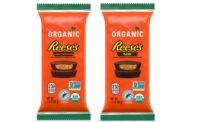Global vegan chocolate market to reach $1.41B in 2028
Ethical concerns, lactose intolerance among driving factors.

The global vegan chocolate confectionery market size is expected to reach $1.41 billion by 2028, increasing at a compound annual growth rate (CAGR) of 14.8 percent, Grand View Research, Inc. reveals in a new report.
The market research firm says growing awareness about animal cruelty and the rise in environmental protection campaigns are expected to be the major factors driving market growth. Vegan chocolate is popular among consumers following a flexitarian or vegan diet, as well as consumers with lactose intolerance and other food allergies.
Key insights:
- Asia Pacific is expected to be the fastest-growing regional market during the forecast period due to the rising cases of lactose intolerance and an increasing number of vegans in the region.
- The chips and bites segment is expected to register the fastest CAGR from 2021 to 2028, owing to the wide application scope of chips and bites in premium bakery products.
- North America dominated the global market, accounting for a revenue share of over 37 percent in 2020.This growth was credited to the rising demand for vegan and dairy-free products in North America.
The molded bars product segment led the market and accounted for the highest revenue share in 2020. Bar chocolates are the most consumed chocolate form in the world. According to an October 2019 study conducted by Google, the Top 5 favorite chocolates in the world, based on their annual searches, are sold in bar form.
The milk chocolate segment accounted for the largest share in the market in 2020, thanks to high demand for these sweet and creamy products. According to the Google study, Cadbury Dairy Milk Chocolate was considered to be the most popular chocolate bar in the world. The milk chocolate bar received, on average, a total of 466,680 searches annually. These market trends are anticipated to increase the product demand.
The offline distribution channel accounted for the largest share of the global market in 2020. This segment is projected to retain its dominance throughout the forecast period, due to consumers’ inclination toward shopping in supermarkets and convenience stores, where they can physically examine the product quality. The global market is fragmented with the presence of a large number of global and regional players.
Looking for a reprint of this article?
From high-res PDFs to custom plaques, order your copy today!






